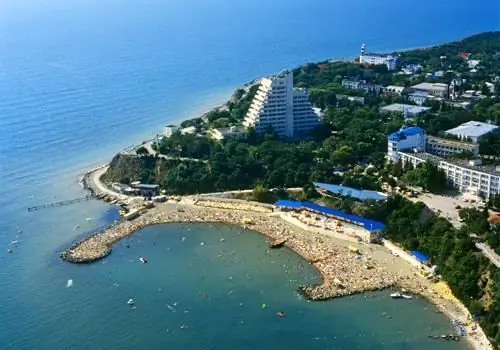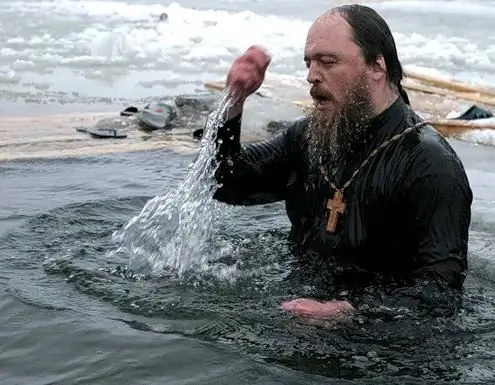- Author Harold Hamphrey [email protected].
- Public 2023-12-17 10:06.
- Last modified 2025-01-24 11:10.
This complex of buildings is very popular not only among those who live relatively close, but even among foreigners. The Trinity-Sergius Lavra in winter is a mesmerizing picture of blue and white. But what lies behind this beauty?
History
Most Orthodox are at least familiar with the name of Sergius of Radonezh. This highly revered saint was repeatedly mentioned in the history of Russia in the XIV century. Among other things, one of his merits, obvious even today, is the foundation in 1334 of the Trinity-Sergius Lavra, to which pilgrims and tourists flock from a huge number of cities and villages, even from other countries.
Now it's hard to imagine, but at first the monastery had a very difficult time - there was practically no means of subsistence. But difficult times passed, the Sergius Lavra farmstead grew, and it became the largest center of culture and spiritual enlightenment. Many active figures of the Russian Church came out of its walls. In difficult times, the walls of the monastery protected its inhabitants from enemies.

Smaller ones began to form around this spiritual center. With the assistance of local figures, more and more new monasteries and churches were opened in different cities. This also happened under Sergius, but even after his death the process continued. In addition, already several centuries ago, while still in the status of a monastery, the Lavra already boasted an extensive and rich library, which for the most part has survived to this day. Of course, many prominent figures of culture and arts of their time visited the monastery walls. So to perceive the whole complex as just a spiritual center is a bit wrong.
In wartime
It is widely known that in turbulent periods of history, monasteries served as a kind of fortresses and defensive points. Sergius Lavra was no exception. It was regularly attacked by enemies: Poles and Lithuanians (in the 17th century), who tried to dig under its walls; the Germans, after whom there was a need for a global restoration, and even the Russians themselves, who closed or even demolished many churches during the Soviet period. The churches of the Lavra of St. Sergius have withstood all the most difficult milestones in history, and this is another reason to admire the selflessness of the local inhabitants, who have always defended the interests of the spiritual center of Russia.

Main Buildings
Of course, the first thing that comes to mind when someone says "Sergiev Posad Lavra" is snow-white walls and blue domes with stars. This is the Assumption Cathedral, and although it is not the mosteither the largest or the oldest building of the ensemble, it invariably attracts a lot of attention. Seeing it in a photograph, it is simply impossible to believe that this church really exists - it is so beautiful.
The central building is the Trinity Cathedral of the Sergius Lavra. This is the oldest surviving building, built in 1422-1425. It is an important monument of architecture, and the painting of its inner walls is truly precious, because the world-famous Andrei Rublev did the work. In addition, it is here that the main shrine of the Lavra is kept - the relics of Sergius of Radonezh.
The Assumption Cathedral appeared one hundred and fifty years later - in 1585. It was built at the behest of Ivan the Terrible (who, by the way, was baptized in a local monastery) and, perhaps, that is why the building is a bit like the central Moscow churches of the Kremlin. Despite the fact that this religious building did not appear on the territory of the ensemble immediately, it perfectly fit into the surrounding landscape, becoming in fact a symbol of the complex, and even eclipsed the Trinity Cathedral of the Trinity-Sergius Lavra in popularity.
Royal palaces date back to the 17th century. Initially, these premises were intended to receive high-ranking guests, but after a short time the building began to be used as an educational building of the Theological Academy.
Another construction that immediately draws attention to itself is an old bell tower built in the 18th century according to the canons of classical architecture. It limits the cathedral square from the north, and its height is 88 meters, which is higher than similar buildings in Novodevichymonastery and the Kremlin.

In total, there are more than 50 different and in their own way interesting buildings for various purposes on the territory of the ensemble: Mikheevskaya Church, Smolenskaya Church, in which there is an iconostasis from the destroyed temple, located in Moscow on Pyatnitskaya Street, etc. By XIX century, active construction on the territory ceased, and gradually the Lavra came to the form in which we see it now.
Current status
The entire Sergius Lavra (the entire complex of structures) is today a recognized architectural monument and has been included in the UNESCO World Heritage List under number 657 since 1993. At the same time, there are several active monasteries on the territory of the ensemble, and development is still ongoing. Perhaps the times when the monastery flourished are long gone, but it is also impossible to call the current state of affairs a decline. Spiritual life continues, now there are a large number of important institutions related to the Russian Orthodox Church. For example, the Moscow Theological Academy and the Icon Painting School.

Attractions
Besides the buildings, there is something else that attracts visitors here. These are the relics of Sergius of Radonezh, located in the Trinity Cathedral. In addition, there are several holy springs on the territory, the queue for which never seems to dry out. They drink from them, they collect water there to take it with them, in some springs you can even take a dip.
Still here are such shrines asThe Tikhvin and Chernigov icons of the Mother of God, the holy relics of Maxim the Greek and Anthony of Radonezh, the famous icon of St. Nicholas. By the way, Rublev's famous "Trinity" was written specifically for one of the temples of the Lavra, even though it is now in the Tretyakov Gallery.
The local bells are also unique in their own way, some of them even have their own names. In addition, the graves of Boris Godunov and his family are located on the territory of the Lavra. In fact, for every pilgrim and tourist there are their favorite and in their own delightful corners. But at the same time, the visitor does not leave the feeling of the integrity of the entire ensemble - probably this is what makes the Lavra unique.

Services
Sergius Lavra is primarily a complex of functioning Orthodox churches. Therefore, it goes without saying that services and other events are regularly held on their territory.
In the Trinity Cathedral, divine services are held every day: at 5:30 the midnight office begins, at 6:30 - the middle liturgy. On Sundays and holidays, you can come to the prayer service as early as 5 in the morning, starting at 8:30 they are repeated every two hours. Of course, many events are held in other temples, so you can almost always get to the service on the territory of the complex.
Main Holidays
There are many significant dates in the Orthodox calendar. Perhaps every believer has his favorite holidays that are of particular importance to him. As for the Lavra, all its inhabitants also have a day thatis one of the most important of the year for them. This is September 25/October 8 - The Repose of St. Sergius of Radonezh. Every year at this time, especially solemn services are held, to which the Patriarch and other high-ranking clergy come.
Another holiday falls on July 5/18 - Finding the relics of Sergius of Radonezh, one of the main shrines of the Lavra. Various festive events are also scheduled for this date, so these days there are especially many visitors.

Location and route
The relative proximity to the Russian capital is another factor that determined the current situation in which the Sergius Lavra is located. There are several ways to get here, each with its pros and cons.
The first option is a car. Sergiev Posad is located in the direction of the Yaroslavl highway, about 70 kilometers from the capital, so the journey will take about an hour and a half. The advantage of this method is mobility - not far from the Lavra there are several more curious places that will be more convenient to get to with your own transport.
The second option is the bus. Routes in the direction of Sergiev Posad depart regularly from the VDNKh and Shchelkovskaya metro stations. You need to get out in the city, and finding your way there will not be difficult.
The third option is the train. It is also very easy to get to Lavra from the Yaroslavsky railway station, commuter trains depart in this direction approximately every half hour.
The official address looks like thisway: 141300, Moscow region, Sergiev Posad, Holy Trinity Sergius Lavra.

Best time to visit
Sergius-Troitskaya Lavra looks great at any time of the year and day. This is indeed a very beautiful complex of buildings, which is worth seeing at least once with your own eyes. But if you want not only to see, but also to join the spiritual values, it is better to choose one of the church holidays. Trinity-Sergius Lavra in winter and summer is open to visitors daily from 5 am to 9 pm, and during special dates it receives pilgrims and tourists around the clock.
But the ensemble looks especially good in winter. The snow-covered Lavra looks simply unreal, as if descended from heaven. According to the reviews of tourists, winters are generally the best time to visit ancient Russian churches: at this time, a special atmosphere reigns there. Perhaps it is because of her that the Sergius-Troitsk Lavra receives the same guests over and over again. This true calm in the midst of the noisy bustle makes you sit on a bench and just watch the visitors and passers-by go about their business. And this activity is also worth coming here to some extent.
Infrastructure
The popularity among tourists could not go unnoticed, so a number of changes have taken place over the past decades, allowing visitors to feel more comfortable. People say that now benches are placed everywhere on the territory of the complex, you can dine in the refectories, there are church shops, souvenir shops. Forgetful pilgrimsthey can always buy a scarf, a pectoral cross or something else. Of course, there is also a place where you can park your car. And yet, sometimes you are tempted to give up excessive comfort and just take a train ride, contemplating the Russian beauties rushing past the window.
Neighbourhood
After visiting the Trinity-Sergius Lavra, many go to Radonezh, where there is a very famous holy spring where you can swim. And nearby there is another one - the Gremyachiy Key. And although the majority goes to the Lavra purposefully, it probably makes sense to go around all the churches located nearby and perceive them as a single complex, because, in fact, it is so. Having traveled around the Moscow region, you can get to the almost provincial, in comparison with the capital, but no less beautiful Yaroslavl. Excellent examples of Russian architecture can also be seen in Suzdal and Veliky Novgorod. There really is something to see in Russia, the main thing is to start.






